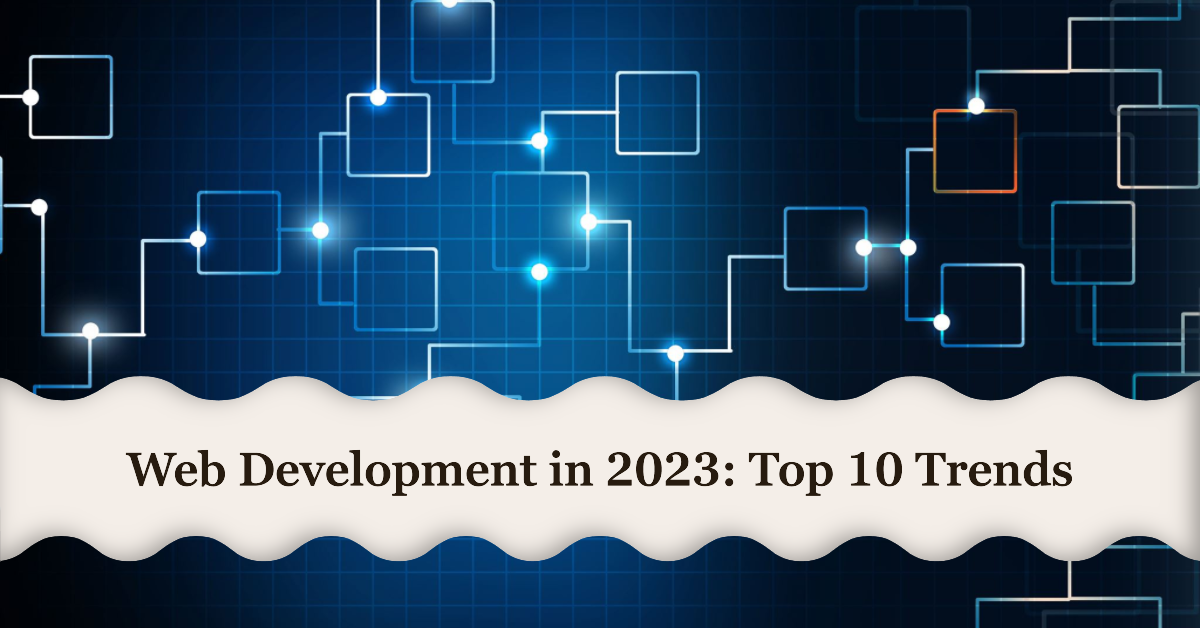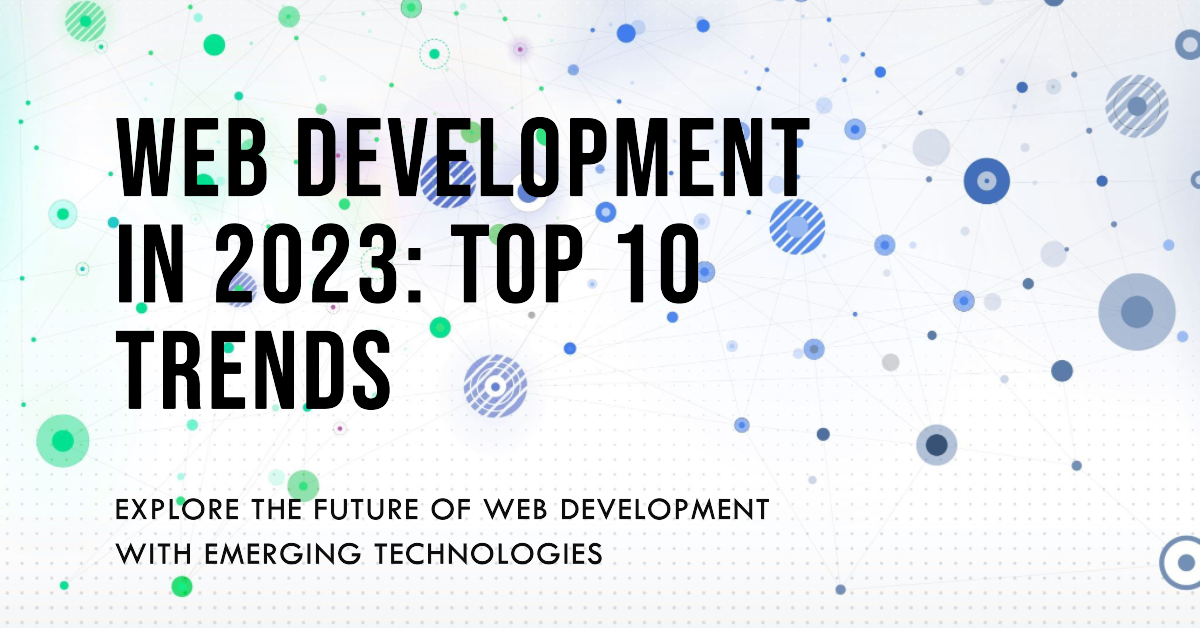Web Development in 2023: The Top 10 Trends to Watch:
Welcome to the exciting realm of web development in 2023. The ever-evolving landscape of technology continues to shape the way we build websites and applications. As we look to the future, it is essential to stay updated on the latest trends and embrace the tools that will drive innovation and success.
In this article, we will explore the top 10 trends that are set to transform the web development industry in 2023. From groundbreaking technologies to emerging frameworks and best practices, we’ll cover it all. So fasten your seatbelt and get ready to embark on a journey into the future of web development.
Web Development Trend #1:
Progressive Web Apps (PWAs) Progressive Web Apps (PWAs) have gained significant traction in recent years, and their popularity is set to soar in 2023. PWAs combine the best of both worlds, offering the capabilities of native mobile apps while being accessible through a web browser. With features like offline functionality, push notifications, and seamless installation, PWAs provide an exceptional user experience across different devices.
PWAs leverage modern web technologies such as Service Workers and Web App Manifests, enabling developers to build fast, engaging, and reliable applications. They eliminate the need for separate development efforts for various platforms, making them highly cost-effective. As a web developer, embracing PWAs in 2023 will empower you to deliver impressive experiences to your users.

Web Development Trend #2:
Artificial Intelligence (AI) and Machine Learning (ML) AI and ML are revolutionizing various industries, and web development is no exception. In 2023, integrating AI and ML into web applications will be a game-changer. These technologies enable websites and applications to provide personalized experiences, intelligent recommendations, and advanced data analysis.
AI-powered chatbots and virtual assistants are becoming more sophisticated, enhancing customer support and user interactions. ML algorithms can analyze vast amounts of data, enabling predictive analytics and improved decision-making. With the availability of powerful AI and ML frameworks and libraries, web developers can leverage these technologies to create smarter, more intuitive web experiences.
Web Development Trend #3:
Voice User Interfaces (VUIs) Voice user interfaces (VUIs) have gained immense popularity with the rise of smart speakers and virtual assistants. As voice recognition technology continues to improve, integrating VUIs into web applications will become a prevalent trend in 2023. Users can interact with websites and applications using voice commands, providing a hands-free and convenient experience.
Web developers will need to optimize their applications to support voice inputs and provide voice-driven responses. Natural Language Processing (NLP) and speech recognition APIs enable developers to build robust VUIs. By embracing VUIs, web developers can enhance accessibility, improve user engagement, and stay ahead of the curve in 2023.
Web Development Trend #4:
Low-Code and No-Code Development In an era of rapid digital transformation, low-code and no-code development platforms are empowering individuals with limited coding skills to build web applications. These platforms provide intuitive interfaces, drag-and-drop functionalities, and pre-built templates, enabling faster development cycles.
With low-code and no-code tools, developers can create prototypes, MVPs (Minimum Viable Products), and even fully functional applications without diving deep into coding. In 2023, these platforms will continue to evolve, offering more flexibility and customization options. Web developers can leverage low-code and no-code development to accelerate their projects and streamline collaboration with non-technical stakeholders.
Web Development Trend #5:
Jamstack (JavaScript, APIs, and Markup) Jamstack is a modern architecture for web development that prioritizes performance, security, and scalability. By decoupling the frontend and backend, Jamstack allows developers to build fast and dynamic websites using JavaScript, APIs, and pre-rendered markup.
In 2023, Jamstack will gain further momentum, driven by the need for high-performing websites and improved developer productivity. Static Site Generators (SSGs) such as Gatsby and Next.js enable developers to create dynamic websites while maintaining the benefits of static sites, like fast loading speeds and improved security. The flexibility of Jamstack makes it an ideal choice for a wide range of web applications.
Web Development Trend #6:
Augmented Reality (AR) and Virtual Reality (VR) AR and VR technologies are no longer limited to gaming and entertainment; they are increasingly being integrated into web applications. In 2023, web developers will leverage AR and VR to deliver immersive experiences and engage users in new and exciting ways.
AR allows users to overlay virtual objects onto the real world, enhancing e-commerce experiences, product visualization, and remote collaboration. VR creates fully immersive environments, enabling virtual tours, training simulations, and interactive storytelling. Web developers will harness frameworks like A-Frame and React 360 to build AR and VR experiences that blur the line between the physical and digital worlds.
Web Development Trend #7:
Blockchain Technology Blockchain, the technology underlying cryptocurrencies like Bitcoin, is extending its reach beyond financial applications. In 2023, web developers will explore the potential of blockchain for enhancing security, transparency, and decentralized systems.
Blockchain can be leveraged for various purposes, including secure user authentication, decentralized storage, and smart contract execution. By utilizing blockchain frameworks like Ethereum or Hyperledger Fabric, web developers can build applications with tamper-proof records, traceability, and enhanced privacy.
Web Development Trend #8:
Cybersecurity and Privacy With cyber threats on the rise, cybersecurity and privacy have become paramount concerns for web developers and users alike. In 2023, web developers will focus on implementing robust security measures and privacy features to protect sensitive data and ensure user trust.
Implementing secure coding practices, using encryption protocols, and conducting regular security audits will be essential for web developers. Compliance with privacy regulations, such as GDPR and CCPA, will also be a top priority. By prioritizing cybersecurity and privacy, web developers can build applications that inspire confidence and safeguard user information.
Web Development Trend #9:
Serverless Architecture Serverless architecture is gaining popularity as a cost-effective and scalable approach to web development. With serverless platforms like AWS Lambda and Azure Functions, developers can focus on writing code without the need to manage infrastructure.
In 2023, serverless architecture will continue to grow, offering benefits such as automatic scaling, reduced operational costs, and increased development speed. Developers can leverage serverless functions to handle specific tasks or build entire applications. By adopting a serverless approach, web developers can focus on creating value-added features and delivering exceptional user experiences.
Web Development Trend #10:
WebAssembly (Wasm) WebAssembly (Wasm) is a low-level binary format that enables near-native performance for web applications. In 2023, Wasm will gain momentum as more developers realize its potential for running computationally intensive tasks in the browser.
Wasm allows developers to write code in languages like C, C++, or Rust and compile it to run directly in the browser. This opens up possibilities for complex simulations, data processing, and even running existing software on the web. With improved tooling and increased browser support, WebAssembly will unlock new opportunities for web developers in 2023.
Conclusion:
In conclusion, web development in 2023 promises to be an exciting and transformative journey. The top 10 trends discussed in this article, including Progressive Web Apps, AI and ML integration, Voice User Interfaces, and Jamstack, are set to reshape the web development landscape.
As a web developer, it is crucial to stay updated on these trends and adapt to the changing industry. Embrace new technologies, explore emerging frameworks, and follow best practices to deliver exceptional web experiences. By leveraging these trends, you can stay ahead of the curve and create websites and applications that captivate users in 2023 and beyond.
So, are you ready to dive into the future of web development? Let’s embark on this thrilling adventure together!




